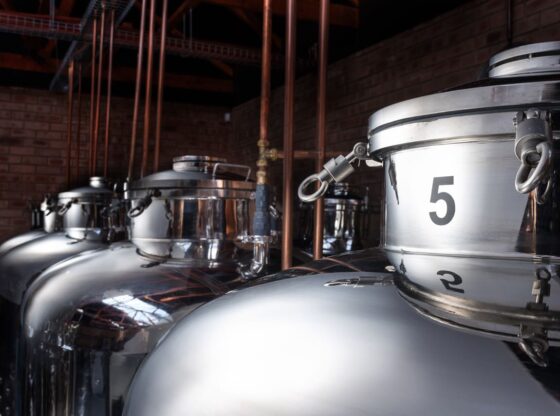
By Hendre’ Barnard, Training and Marketing Manager
Distillique Beverage (Pty) Ltd.
https://distillique.co.za
Click <Here> to see more of Hendre’s articles.
The most common questions that arise from Home Distillers refers to Fermentations. Either failed fermentations, insufficient yield, questions regarding nutrients, temperatures, etc.
What is and is not important when approaching your fermentation?
First off – we must remember that yeast is yeast and fermentation is fermentation, regardless of what raw material we are working with. Therefore, regardless whether you are working with Fruit, Grain, Sugar, Molasses, Cane Syrup, Blue Agave Dex or any other source of fermentable sugars (or starch that can be converted to the same) we always need to keep in mind the same basic principles, and ask ourselves the same basic questions.
Many of these questions are influenced by certain decisions we make, i.e. the type of yeast we choose to use, the type of raw material we are using, whether we are distilling commercially or for own use, and what our final product will be.
STEP 1: Are you distilling for own use or commercially?
Why is this important? Simply because the Home Distiller is free to make certain changes, additions and manipulations to the fermentation that will affect the outcome (specifically the addition of sugar to increase the alcohol yield). Commercial Distillers are not allowed this freedom, and therefore are limited to the sugar their raw materials naturally provide them.
STEP 2: How much sugar do you have, or do you want to have?
Remember that sugar is the source of alcohol. No sugar, no fermentation, no alcohol. So obviously the more sugar the better, right? To a point this is correct, but two aspects of the yeast you choose to use plays a role here – Sugar Tolerance and Alcohol Tolerance. The latter normally plays more of a role here than the former.
Alcohol Tolerance is the percentage ABV (alcohol by volume) at which the yeast will die because of excessive alcohol presence.
Sugar Tolerance (more accurately the Brix Tolerance) is the Brix percentage at which the Yeast will die due to excessive sugar. The sugar, at high concentrations, acts as a desiccant and “pulls water” from the yeast cell. In the process the yeast cell gets dehydrated and dies.
Between these two points – The amount of sugar that will form the maximum amount of alcohol tolerable, and the amount of sugar that will kill the yeast outright, lays waste. Sugar added that will not be fermented as the yeast will die due to excessive alcohol before getting a chance to ferment. This concern will normally only play a role for Home Distillers, as the normal sugar yield of most raw materials will always be lower than either the alcohol tolerance or the sugar tolerance of the yeast.
Excessive sugar will only play a role when using sources of extremely high sugar content like Molasses or Cane Syrup with Brix values higher than say 32%. In these cases, both the Home and Commercial Distiller needs to adjust the Sugar Content of the fermentation downwards through dilution to avoid waste. Both dilution and addition formulas are discussed in detail in our Article regarding Sugar Calculations.
STEP 3: What yeast will you use?
As stated before, two aspects of yeast will affect your choices right from the start – Alcohol Tolerance and Sugar Tolerance. If you are commercially distilling you do not need to use yeast with an alcohol potential of 18% ABV if you only have enough sugar in your fermentation to produce a fermentation up to 9% ABV. On the other hand, if you are dealing with high sugar content raw materials, you should consider rather using a higher alcohol potential yeast.
Another important consideration would be which tastes you wish to extract or add to your product during fermentation. Certain yeast strains have been specifically developed for use with certain raw materials, like Speyside Whisky yeast. Others, like Rhone 4600, are preferred for use with fruit as it is more effective in preserving or enhancing the fruity aromas through the fermentation process.
STEP 4: How do you limit Methanol formation?
Methanol is an unavoidable by-product of Alcohol Fermentation. All we can do is limit how much will form. With fruit this entails the removal of all woody components from the fermentation – pips, stones, stems, leaves and the skin or peels in some cases. Your “white fruit” like apples, pears and bananas pose a different problem, in that the “white” structure of the fruit is an indication of the presence of Pectin, a component of the cell structure that is a forerunner of cellulose and will lead to methanol formation. When using these fruits (and others with “fleshy” structures) it is best to use Pectolase, an artificial enzyme that breaks Pectin down to fermentable sugars, thereby both reducing methanol formation and increasing the yield at the same time.
With both Fruit and Grain fermentations we need to choose whether to do a mash fermentation including the solids, or to filter the solids out prior to fermentation. A solid in this case refers to peels and skins with fruit, and bran or husks with grain. This will be an important choice for you, as fermenting on the skin or bran will add more flavour to your product but increase the methanol concentration. On the other hand, removing the solids prior to fermentation will limit the methanol concentration, but decrease the flavour content.
STEP 5: Do you need to add nutrients to your fermentation?
Regardless of the type of yeast or type of fermentation, both Nitrogen and Vitamin B is always required for successful respiration and fermentation. The only raw materials that have enough nutrients naturally are grain and potatoes. Fruit have nutrients, but the wrong type of nutrients. For example: Vitamin C is not really beneficial for fermentation. Although certain sugar types or sugar bases have the right type of nutrients, the concentration is never enough for successful fermentation. Therefore, your answer to this question, do you need to add nutrients to your fermentation, will always be YES, except if you are using Grain or Potatoes.
Commercial Yeast nutrients are very convenient, but you can also make your own nutrients. Please see our Article on this for more information. Nutrients are, as a rule of thumb, added on a gram to gram basis with yeast.
STEP 6: What should my pH level be?
As with Sugar and Alcohol Tolerances, each yeast works best at a given pH level, although this normally has more to do with the raw material than the yeast. For fruit our pH should be between 3.5 and 4.5, for grain between 5.5 and 6.5.
REMEMBER – during the first couple of days of fermentation the pH WILL drop (once of the indications of a successful fermentation) therefore it is better to start at the upper level (either 4.5 or 6.5) to allow for this drop without negatively impacting the yeast. This is especially true for fruit fermentations.
To adjust your pH upwards (more alkaline) use Potassium Carbonate. Alternatively, you can use Citric Acid to adjust you pH downwards (more acidic) until you reach your target pH level. There is no general rule, formula, or any other method to determine how much you should add for a specific adjustment. It is a matter of adding a little, measuring, adding a little, measuring, until you reach your goal. Specifically with Potassium Carbonate – add small amounts to avoid foaming and the fermentation boiling over. In this process a Digital pH meter is very handy and accurate but treat it carefully as it is very sensitive and prone to damage. pH strips are less accurate, but more than sufficient.
Please read our article on Bacterial Infections in Fermentations as well, as it relates to pH.
STEP 7: What water should you use in your Fermentation?
There is no need to use reverse osmosis or distilled water during fermentation – in actual fact it may be detrimental to the fermentation due to the lack of minerals in the water that the yeast needs. Two possible concerns would be water with high chlorine content, as the chlorine will kill the yeast, or water with very HIGH mineral content (some borehole or spring water) that will have the same effect. In the first case a commercial or household chlorine filter would suffice. For hard water, a water softening agent can be used. However, too soft water is also not beneficial.
STEP 8: Do you have enough oxygen in your Fermentation?
During the fermentation process we use both methods of energy creation by yeast. Respiration (aerobic) and fermentation (anaerobic). In the presence of oxygen, yeast respires and reproduces. This allows us to use a relatively small amount of yeast on large batches. However, no oxygen, no respiration, and we have a failed or stuck fermentation. We therefore have to aerate our fermentation by shaking, splashing, bubbling or any other method to ensure respiration and reproduction.
Should this however go on unchecked, as in an open fermentation, the yeast will use our sugar for reproduction energy, and not produce alcohol. Alcohol production happens during fermentation as a survival mechanism in the absence of oxygen, hence the importance of using a Fermentation Lock, Airlock, One Way Valve or Bubbler. This allows respiration to a point, (until all oxygen is consumed) and then enforces fermentation (with no oxygen available) and the creates a carbon dioxide rich environment (while still allowing pressure release).
STEP 9: What temperature should you ferment at?
For every 10 degree increase in temperature, chemical reactions in a fermentation doubles (within bounds), therefore the higher the temperature, the quicker the fermentation. BUT … The more chemical reactions take place, the more congeners (long chain molecules – normally associated with bad tastes and aromas) form during the fermentation. Ideal fermentation temperature (balanced between time and congener formation) is therefore around 12 to 22 degrees Celsius (fermentation time of around 10 days), (depending on the yeast used) with the maximum being between 28 and 30 degrees Celsius (fermentation time of around 7 days). Most “distilling” yeasts require a temperature range between 24 and 28 degrees Celsius.
STEP 10: How do you know your fermentation is completed or successful?
All successful fermentations share the following:
- They produce alcohol and carbon dioxide (CO2)
- They produce little unwanted congeners (impurities)
- Their pH drops initially (i.e. become more acidic)
- They generate heat
- They consume all fermentable sugars (we call it a “dry fermentation”)
The actual release of carbon dioxide (bubbling) is an indication of continued fermentation, and if this stops, we know the fermentation has stopped. But this does not mean my fermentation is completed or successful.
A SG reading is the correct way to determine whether or not a fermentation is completed successfully. If any sugar is still present in your fermentation, then you have a failed fermentation, unlike wine and beer fermentations where we sometimes leave sugar unfermented (residual sugars) for taste and mouthfeel purposes.
For more information on this, please read our Articles on Failed Fermentations and Fermentation Monitoring.
Following the steps above during the planning and preparation of your fermentations, you will find a larger number of successful fermentations and also better alcohol yields, less methanol, less congeners and better flavour profiles in your product.
Have fun and keep on Distilling!


